Chapter 11 Strategic Management Accounting and Processes
LEARNING OBJECTIVES 1. Understand the basic concept of strategy. |
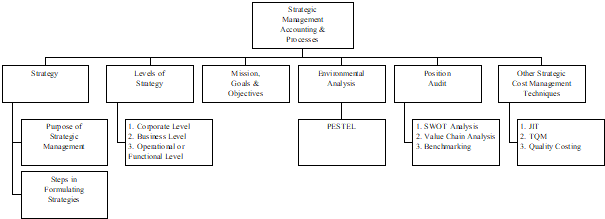
1. What is Strategy?
1.1 Definition of strategy
1.1.1 |
Definitions |
|
(a) Strategy is the direction and scope of an organization over the long term, which achieves competitive advantage in a changing environment through its configuration of resources and competencies with the aim of fulfilling stakeholder expectations. |
1.2 Purpose of strategic management
1.2.1 Strategic management enables all of the following through
(a) providing a framework for the organization which states clear long-term goal and ensures harmony of objectives (goal congruence);
(b) creating milestones to assess the achievement of goals and to monitor progress;
(c) detecting and responding to changes in market and environmental forces in order to improve performance;
(d) improving relationships with and perceptions of stakeholders;
(e) developing the potential of future management and aid succession planning.
1.3 Overviews of steps involved in formulating strategies
1.3.1 The steps are as follows:
Step 1: Conduct a corporate appraisal (assess the internal and external environment of the organisation).
Step 2: Set mission and objectives – the long term aims of the organisation may be broken down into shorter term, more measurable targets.
Step 3: Gap analysis – compare forecast performance with strategic objectives to expose 'gaps' which need to be filled by new or different strategies.
Step 4: Strategic choice – generate options and evaluate them to decide on which ones have the potential to succeed. => e.g. cost leadership
Step 5: Strategy implementation – carry out the strategy at corporate, business and functional level.
2. Levels of Strategy
2.1 There are many levels of strategy in an organization:
(a) Corporate level – the general direction of the whole organization.
(b) Business level – how the organization or its strategic business units (SBUs) tackle particular market. E.g. Subsidiaries, segements
(c) Operational or functional level – specific strategies for different departments of the business.
2.2 |
Example 1 – Levels of strategy |
|
ABC Ltd is a company selling widgets. The finance director says: 'We plan to issue more shares to raise money for new plant capacity – we don't want loan finance – which will enable us to compete better in the vital and growing widget markets of Latin America. After we've promised the shareholders 5 per cent profit growth this year, and trading is tough. What are the corporate, business and functional strategies in the above statement?
|
3. Mission, Goals and Objectives
3.1 |
Definitions |
|
(a) Mission – broad, general statements that tell why your organization exists. These do not usually change from year to year. |
3.2 |
Example 2 – Mission, Goals and Objectives: Restaurant Example |
|
1. Mission: Provide to our valued customers prompt and high quality food and service in a friendly and courteous manner.
3. Objectives:
4. Specific actions: To reduce cholesterol… To improve customer perception of courtesy… |
4. Corporate Appraisal: Environmental Analysis
4.1 Three concentric layers of environment
4.1.1 The environment may be divided for convenience into three concentric layers:
(a) Macro-environment
(b) Industry or sector
(c) Competitors and markets
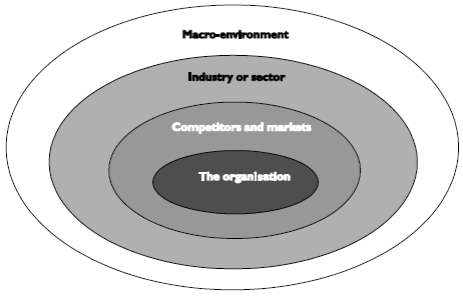
4.2 PESTEL
(Jun 09)
4.2.1 The macro-environment may be analysed into six segments using the PESTEL framework. Analysis of the macro-environment is commonly based on breaking it down into a handful of major aspects.
(a) Political
(b) Economic
(c) Socio-cultural
(d) Technological
(e) Environmental protection
(f) Legal
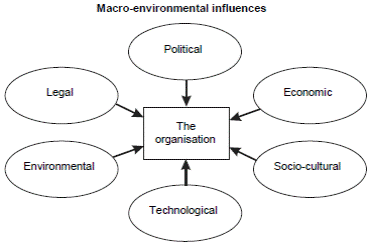
4.2.2 The acronym PESTEL is sometimes replaced by PESTE, in which the legal aspect is incorporated with political; SLEPT, in which the environmental protection aspect is folded into the other five; or even by STEEPLE, where the extra 'E' stands for ethics.
4.2.3 Remember, though, that PESTEL is only concerned with the external environment, not the internal capabilities of an organisation.
(a) Political environment
4.2.4 Government policy affects the whole economy, and governments are responsible for enforcing and creating a stable framework in which business can be done. A report by the World Bank indicated that the quality of government policy is important in providing three things:
(a) Physical infrastructure (for example, transport)
(b) Social infrastructure (education, a welfare safety net, law enforcement, equal opportunities)
(c) Market infrastructure (enforceable contracts, policing corruption)
4.2.5 The political risk in a decision is the risk that political factors will invalidate the strategy and perhaps severely damage the firm. Examples are wars, political chaos, corruption and nationalisation.
(b) Economic environment
4.2.6 The economic environment affects firms at national and international level, both in the general level of economic activity and in particular variables, such as exchange rates, interest rates and inflation.
Factors |
Potential impacts |
Overall growth or fall in GDP |
Increased/decreased demand for goods (for example, dishwashers) and services (for example, holidays) |
Local economic trends |
Type of industry in the area, office/factory rents, labour rates, property prices |
Inflation |
How much it costs to borrow money affects cash flow, some companies carry a high level of debt, consumer spending is affected by rises in interest rates |
Interest rates |
Corporate tax affects how much firms can invest or return to shareholders, income tax affects how much consumers have to spend therefore demand |
Tax levels |
Corporate tax affects how much firms can invest or return to shareholders, income tax affects how much consumers have to spend therefore demand |
Government spending |
Suppliers to the government (for example, construction firms) are affected by spending |
Business cycle |
Economic activity is always punctuated by periods of growth followed by decline, simply because of the nature of trade. Government policy can cause, exacerbate or mitigate such trends, but cannot abolish the business cycle. (Industries that prosper when others are declining are called counter-cyclical industries.) |
4.2.7 Impact on international factors on the economic environment
Factors |
Potential impacts |
Exchange rates |
Cost of imports, selling prices and value of exports; cost of hedging against fluctuations |
Characteristics of overseas markets |
Desirable overseas markets (demand) or sources of supply (cheap imports?) |
International capital market |
Generally, advanced economies accept that supply and demand set the value of their currencies, using interest rates only to control inflation |
Large multinational companies (MNCs) |
MNCs have huge turnovers and significant political influence because of governments' desire to attract capital investment |
Government policy on trade/protection |
Cost of barriers to trade, effect on supplier interests of free trade, erection of reciprocal barriers, possibility of dumping |
(c) Socio-cultural environment
4.2.8 The social and cultural environment features long-term social trends and people's beliefs and attitudes.
Factors |
Comment |
Growth |
The rate of growth or decline in a national population and in regional populations |
Age |
Changes in the age distribution of the population. In some countries, there will be an increasing proportion of the national population over retirement age. In developing countries there are very large numbers of young people |
Geography |
The concentration of population into certain geographical areas |
Ethnicity (種族特點) |
A population might contain groups with different ethnic origins from the majority |
Household and family structure |
A household is the basic social unit and the number of children might determine its size, whether elderly parents live at home and so on |
Social structure |
The population of a society can be broken down into a number of subgroups, with different attitudes and access to economic resources. Social class, however, is hard to measure (as people's subjective perceptions vary) |
Employment |
In part, this is related to changes in the workplace. Many people believe that there is a move to a casual flexible workforce; factories will have a group of core employees, supplemented by a group of insecure peripheral employees, on part-time or temporary contracts, working as and when required. |
Wealth |
Rising standards of living lead to increased demand for certain types of consumer goods. This is why developing countries are attractive as markets |
(d) Technological environment
4.2.9 Technology contributes to overall economic growth. There are three ways in which technology can increase total output:
(a) Gains in productivity (more output per units of input)
(b) Reduced costs (for example, transportation technology)
(c) New types of product
(e) Environmental protection
4.2.10 Environmental protection is now a key aspect of corporate social responsibility. Pressure on businesses for better environmental performance is coming from many quarters.
4.2.11 Green issues will certainly impinge on businesses in the future. Pressures on businesses for environmental action are increasing. Factors to consider include those listed below:
(a) Consumer demand for products that appear to be environmentally friendly (for example, wood from sustainable forests)
(b) Demand for less pollution from industry
(c) Greater regulation by government (for example, recycling targets)
(d) Demand that businesses be charged with the external cost of their activities
(e) Scarcity of non-renewable resources (for example, the need to find alternative fuels to replace oil when current reserves run out)
(f) Opportunities to develop products and technologies that are environmentally friendly
(g) Taxes (for example, some sort of tax on landfill or excess packaging or similar)
(f) Legal environment
4.2.12 The following list highlights possible legal factors affecting all companies:
Factors |
Example |
General legal framework: contract, tort, agency |
Basic ways of doing business, negligence proceedings, ownership, rights and responsibilities, property |
Criminal law |
Theft, insider dealing; bribery, deception, industrial espionage |
Company law |
Directors and their duties, reporting requirements, takeover proceedings, shareholders' rights, insolvency |
Employment law |
Trade Union recognition, minimum wage, unfair dismissal, redundancy, maternity |
Health and safety |
Fire precautions, safety procedures |
Data protection |
Use of information about employees and customers |
Marketing and sales |
Laws to protect consumers (for example, refunds and replacement, 'cooling off' period after credit agreements), what is or isn't allowed in advertising |
Environment |
Pollution control, waste disposal |
Tax law |
Corporate tax payment, collection of income tax |
Competition law |
General illegality of cartels |
5. Corporate Appraisal: Position Audit
5.1 SWOT analysis
5.1.1 |
SWOT analysis |
|
SWOT analysis is a systematic method for detailing the strengths, weaknesses, opportunities and threats to an organisation. It attempts to provide a picture of the organisation's position relative to the impact of important internal and external factors and is therefore a useful part of the first step in formulating strategies. |
5.1.2 How can we start a SWOT analysis? One approach is to follow these four steps:
Step 1: List the key factors for success
Step 2: Outline the major outside influences and their impact on our business
Step 3: Give an assessment of our company versus our competitors. Highlight the differential strengths and weaknesses
Step 4: Give an explanation for good or bad performance
5.1.3 A potential problem with SWOT analysis is the development of a long list of unweighted factors. If the situation review is to be of assistance to strategic planning, these factors must ultimately be ranked in order of priority to the organisation. This allows for greater focus when developing specific strategies. A way of organising the four factors is in a table, as follows:
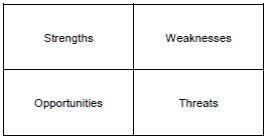
5.1.4 Some examples that might be uncovered by an in-depth SWOT analysis:
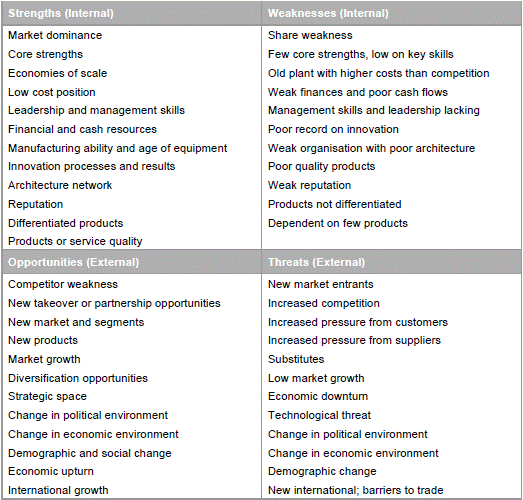
5.1.5 Internal/external analysis and SWOT/PESTEL provide useful tools to evaluate a business's current position and to assist in guiding strategy formulation.
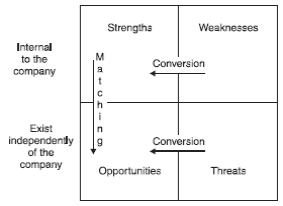
5.1.6 |
Example 3 – SWOT |
|
The Hong Kong Jockey Club is one of the largest racing organisations in the world. Horse racing is the most popular spectator sport in Hong Kong and through its subsidiaries, the Club is the only authorised operator of horse racing. It also operates the Mark Six lottery and under Government authority offers betting on football matches held outside Hong Kong. The Club is the largest single taxpayer in Hong Kong – HK$12,976 million in 2008/09, or about 6.8 per cent of all taxes collected by the Government's Inland Revenue Department. A unique feature of the Club, much admired worldwide, is its not-for-profit business model whereby its surplus goes to charity. Over the past decade, the Club has donated an average of one billion Hong Kong dollars every year to hundreds of charities and community projects. Today, the Club ranks alongside organisations such as the Rockefeller Foundation as one of the biggest charity donors in the world. The Club is also one of the largest employers in Hong Kong, with some 5,300 full-time and 21,000 part-time staff. The racing arm of the Hong Kong Jockey Club operates two thoroughbred race tracks in Hong Kong – at Happy Valley and Sha Tin. Racing is held at Happy Valley on Wednesdays mostly in the evenings, and at Sha Tin on Sundays mostly in the daytime. Racing facilities in Hong Kong are among the finest in the world. Happy Valley's historic race track at Happy Valley, with its spectacular cityscape setting, offers racegoers a truly electric atmosphere, especially during night meetings. Sha Tin Racecourse, opened in 1978, boasts some of the world's most sophisticated racing facilities and plays host to Hong Kong's major international events. Its high-resolution diamond vision screen is the longest TV display in the world, while the recently-opened covered Parade Ring sets new standards of comfort and access for racing fans with its unique, retractable paddock roof. Required: Access the website of the Hong Kong Jockey Club (www.hkjc.com/english/) and address the following issues: Solution: 1. Vision and Mission Mission – To provide total customer satisfaction through meeting the expectations of all Club customers and stakeholders – the racing and betting public; lottery players; Club Members; charities and community organisations; Government; and ultimately, the people of Hong Kong and thereby be one of Hong Kong's most respected organisations. 2. SWOT analysis
Weaknesses (internal)
Opportunities (external)
Threats (external)
|
5.2 Value chain analysis
(Dec 09, Jun 11)
5.2.1 |
Value chain analysis |
|
The value chain describes those activities of the organisation that add value to purchased inputs. Primary activities are involved in the production of goods and services. Support activities provide necessary assistance. Linkages are the relationships between activities. |
5.2.2 Michael Porter grouped the various activities of an organization into a value chain.
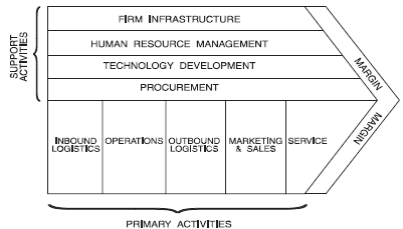
5.2.3 The margin is the excess the customer is prepared to pay over the cost to the firm of obtaining resource inputs and providing value activities. It represents the value created by the value activities themselves and by the management of the linkages between them.
5.2.4 Primary activities are directly related to production, sales, marketing, delivery and service.
(Jun 11)
Activity |
Comment |
Inbound logistics |
Receiving, handling and storing inputs to the production system: warehousing, transport, stock control and so on |
Operations |
Converting resource inputs into a final product: resource inputs are not only materials. People are a resource, especially in service industries |
Outbound logistics |
Storing the product and its distribution to customers: packaging, testing, delivery and so on; for service industries, this activity may be more concerned with bringing customers to the place where the service is available; an example would be front of house management in a theatre |
Marketing and sales |
Informing customers about the product, persuading them to buy it, and enabling them to do so: advertising, promotion and so on |
After-sales service |
Installing products, repairing them, upgrading them, providing spare parts and so forth |
5.2.5 Support activities provide purchased inputs, human resources, technology and infrastructural functions to support the primary activities. It may seem an obvious point that support activities need to support the primary activities, but do not overlook it. For example, staff recruitment and training need to be appropriate for the product being produced in the operations.
(Dec 09, Jun 11)
Activity |
Comment |
Procurement |
All of the processes involved in acquiring the resource inputs to the primary activities (for example, purchase of materials, subcomponents equipment) |
Technology development |
Product design, improving processes and resource utilization |
Human resource management |
Recruiting, training, managing, developing and rewarding people; this activity takes place in all parts of the organisation, not just in the HRM department |
Firm infrastructure |
Planning, finance, quality control, the structures and routines that make up the organisation's culture |
5.2.6 Linkages connect the activities of the value chain.
(a) Activities in the value chain affect one another. For example, more costly product design or better quality production might reduce the need for after-sales service.
(b) Linkages require co-ordination. For example, Just In Time requires smooth functioning of operations, outbound logistics and service activities such as installation.
5.3 Benchmarking
5.3.1 |
Benchmarking |
|
Benchmarking is a tool that helps to aid teams in problem solving. It involves studying organizations that are among the best in the business world for performing a particular task. For example, companies with similar business nature, processes, size and turnover would be selected for the benchmarking process. The performance of different organizations, subsidiaries or investment centres can be compared (benchmarked) by calculating suitable financial or non-financial ratios for each of them to ascertain which are better or worse than the average. |
5.3.2 |
Example 4 – Benchmarking |
||||||||||||||||||||||||||||||||||||||||||||||||||||||||||||||||||
|
A typical example of benchmarking can be done by: (a) Inter-year comparison
(b) Industry comparison
(c) International comparison
|
6. Other Strategic Cost Management Techniques
6.1 Just-in-Time (JIT)
(Dec 12)
6.1.1 |
JIT |
|
JIT system is a system in inventory management by which materials ordered are received just as they are needed and so avoiding the need to carry any materials or components inventory. It is generally known as demand driven as production and delivery are done immediately after the order is made. |
6.1.2 There are two aspects to JIT systems, namely, JIT purchasing and JIT production.
6.1.3 JIT purchasing seeks to match the usage of materials with delivery from outside suppliers and keeping stocks at nearly zero level. It requires:
(a) Confidence that suppliers will deliver exactly on time.
(b) Delivery of 100% quality materials by suppliers with no rejects, no returns and no production delays.
As a result, a close working relationship with the suppliers is necessary and the reliability of suppliers is important.
6.1.4 JIT production is a demand-pull concept and tends to eliminate waste and avoiding production bottlenecks. Such improvements are necessary for the introduction of advanced manufacturing technology (AMT) and total quality management (TQM).
6.1.5 |
Benefits of JIT |
|
(a) Reduction in inventory holding costs |
6.2 Total Quality Management (TQM)
(Jun 12, Dec 12)
6.2.1 |
TQM |
|
TQM is an organization-wide effort to seek continuous improvement in all aspects of operations. It suggests that products should be of zero defects and do right in the first time. The characteristics of TQM are: TQM is an important concept for companies, particularly manufacturing ones, as the cost of poor quality products is huge as that could involve additional costs and could also damage the image of the company in the long run. |
6.2.2 |
Cost associated with quality |
|
(a) Prevention costs – incurred in preventing poor quality products and services but always difficult to ensure that product or service produced are absolutely non-defective in practice. |
6.3 Quality costing
(Dec 12)
6.3.1 |
Quality costing |
|
It describes the cost that incurred for product or service failures as the company cannot deliver its normal level of service or product quality to its clients and it may include the lost of revenue and cost of bad publicity, etc. |
6.3.2 When considering the quality costing, a cost of quality report is vital as management has to consider the relative importance of each component of total quality cost as a percentage of sales revenue.
Examination Style Questions
Question 1
Apart from financial evaluation, environmental accounting is also becoming important in strategic management. Techniques such as PEST and SWOT analyses are employed by management before they take on a project involving by different departments. In management accounting, departments or divisions can be classified as revenue centre, profit centre, cost centre and investment centre in accordance with the activities they perform.
Required:
(a) What is PEST? Describe briefly what the PEST headings stand for. (6 marks)
(b) Distinguish among revenue centre, profit centre, cost centre and investment centre. Which category would you assign to a government funded hospital organization with annual funding of over $30 million? Can it be treated as a profit centre? Explain briefly. (10 marks)
(c) What is the main rationale behind responsibility accounting? (4 marks)
(HKIAAT PBE II Management Accounting and Finance June 2009 Q6)
Question 2
Sunshine Watch Ltd produces watches and related products. The company is a recognized leader in the industry for quality products. In recent months, the directors have become interested in trying to quantify the costs of quality in the company. As an initial effort, the company was able to identify the following costs for the year ended 30 June 2004, by categories that are associated with quality:
|
$ |
Quality training |
150,000 |
Scrap and waste |
65,000 |
Quality inspections |
180,000 |
Warranty handling |
95,000 |
Waste disposal |
21,000 |
Quality technology |
500,000 |
Test equipment |
140,000 |
Procedure verifications |
90,000 |
Quality circles |
320,000 |
Customer reimbursement/returns |
76,000 |
Managers were also aware that in the above, 250 of the 8,000 watches that were produced had to be sold as scrap. As a result, each of the 250 watches earned $800 less in profit than “good” watches. Also, the company incurred $60,000 rework costs that were necessary in order to sell 200 other watches through regular market channels.
Required:
(a) Prepare a quality cost report for the year ended 30 June 2004 showing clearly the four major categories of quality costs. (12 marks)
(b) Assuming that the company intends to extend the warranty period from one year to two years, describe the impact of this intended change on quality costs. (3 marks)
(c) Briefly describe the characteristics of total quality management (TQM) and explain why it is important to all kinds of organizations. (5 marks)
(HKIAAT PBE II Management Accounting December 2004 Q4)
Question 3
What is a value chain and what are the four support activities in the value chain? (2 marks)
(HKIAAT PBE II Management Accounting and Finance December 2009 Q2(c))
Question 4
Define a value chain and point out the activities in a value chain. (5 marks)
(HKIAAT PBE II Management Accounting and Finance June 2011 Q1(d))
Question 5
State THREE techniques commonly used by management accountants in the strategic management accounting framework. (5 marks)
(HKIAAT PBE II Management Accounting and Finance December 2012 Q1(e))
Source: https://hkiaatevening.yolasite.com/resources/PBEP2Notes/Ch11-Strategy.doc
Web site to visit: https://hkiaatevening.yolasite.com/
Author of the text: indicated on the source document of the above text
If you are the author of the text above and you not agree to share your knowledge for teaching, research, scholarship (for fair use as indicated in the United States copyrigh low) please send us an e-mail and we will remove your text quickly. Fair use is a limitation and exception to the exclusive right granted by copyright law to the author of a creative work. In United States copyright law, fair use is a doctrine that permits limited use of copyrighted material without acquiring permission from the rights holders. Examples of fair use include commentary, search engines, criticism, news reporting, research, teaching, library archiving and scholarship. It provides for the legal, unlicensed citation or incorporation of copyrighted material in another author's work under a four-factor balancing test. (source: http://en.wikipedia.org/wiki/Fair_use)
The information of medicine and health contained in the site are of a general nature and purpose which is purely informative and for this reason may not replace in any case, the council of a doctor or a qualified entity legally to the profession.
The texts are the property of their respective authors and we thank them for giving us the opportunity to share for free to students, teachers and users of the Web their texts will used only for illustrative educational and scientific purposes only.
All the information in our site are given for nonprofit educational purposes